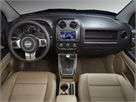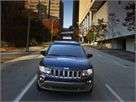Recent Articles
Popular Makes
Body Types
5 Things You Need to Know About the 2011 Jeep Compass

A year can bring big changes in the auto industry, and the 2011 Jeep Compass is a perfect example of just how many improvements can be made within a 12-month window. Jeep set its designers and engineers loose on the Compass platform and what they came back with is a compact sport-utility crossover that has more to offer families and drivers with active lifestyles than its 2010 counterpart. While the vehicle has not undergone a complete redesign, the changes that have been made to the 2011 Jeep Compass were specifically targeted towards areas where buyers would notice the most improvement.
Let’s take a look at five things you need to know about the 2011 Jeep Compass. For even more information and important updates about the compact crossover, please visit Jeep’s 2011 Compass website.
01. The 2011 Jeep Compass Gains a New Look
The 2011 Jeep Compass sports fresh body work from front to back. The Compass’ front fascia has been completely reworked to emulate the styling of its bigger brother, the popular Jeep Grand Cherokee. The seven-bar upright grille and canted headlights make the Compass instantly recognizable as part of the Jeep family, while the new rear LED taillights update the crossover and add additional detail and safety to the vehicle’s design. Keen eyes will also spot the additional body cladding that has been affixed to the lower edge of Jeep’s bumper. The overall effect is a sportier, more streamlined appearance for the small SUV.

02. The 2011 Jeep Compass is Quieter and More Comfortable
A priority for the Compass’ 2011 facelift was to make the crossover a quieter place to spend some time while traveling from point A to point B. This was accomplished through the addition of more noise-absorbent paneling, as well as the increased use of sound insulation throughout the vehicle. Along with these new panels come a host of soft-touch materials that are intended to give the 2011 Jeep Compass a more high-end feel, and the number of hard plastic surfaces that driver and passengers interact with inside the SUV has been dramatically reduced.
Comfort improvements aren’t just restricted to sound and touch – the Compass has also seen its suspension system tweaked in order to provide more confident footing and better absorption of bumps and other insults out on the road. The vehicle’s spring rates have been stiffened by 20 percent and its stabilizer bars by 10 percent in an effort to reduce the bouncing and buffeting that was evident in the 2010 edition of the SUV.

03. The 2011 Jeep Compass Now Offers More Standard Equipment
All versions of the 2011 Jeep Compass now come with amenities such as power windows, air conditioning, cruise control and keyless entry as standard equipment. Dashboard gauges feature LED backlighting for 2011, and an all-new steering wheel that provides controls for the stereo system and cruise control – as well as other vehicle functions – is also included free of charge.
Additional features that can be ordered with the 2011 Jeep Compass include the uConnect Web, Navigation and Voice Command systems, as well as a sunroof, heated leather seats, and speakers which can flip down from the open tailgate and face the rear of the vehicle.

04. The 2011 Jeep Compass has Been Tuned for Better Acceleration
The 2011 Jeep Compass offers the same engine choices as found in 2010, including a 2.0-liter, four-cylinder engine that offers 158 horsepower and 141 lb-ft of torque and a 2.4-liter, four-cylinder unit that generates 172 horsepower and 165 lb-ft of torque. Jeep engineers, however, have reconfigured the programming of the larger motor (which comes standard in all but one version of the vehicle), and the optional continuously-variable automatic transmission that can be paired with it, in order to knock a half-second off of the SUV’s sprint to 60 miles per hour. A five-speed manual transmission is also available with the 2011 Compass.

05. The 2011 Jeep Compass is Now Trail Rated
The 2011 Jeep Compass received significant attention in the off-road capability department in order to help the crossover gain Trail Rated status. This badge is only bestowed upon Jeep vehicles which meet the brand’s highest all-terrain driving standards. The key to up-rating the Compass’ abilities off the beaten path was the inclusion of the Freedom Drive II four-wheel drive system, which comes with a low-range feature thanks to a special version of the continuously-variable automatic transmission that comes with it. Freedom Drive II can distribute torque evenly between the front and rear axles, and versions of the Compass that benefit from this feature also offer skid plates and an additional inch of ground clearance. The Freedom Drive I system is still available for those interested in a more pavement-focused active all-wheel drive system.
